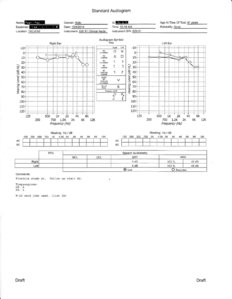@attheedgeofscience Would you mind taking a look at my audiogram and giving me your opinion? My tinnitus is in my left ear. I believe it to be around 9800 kHz.
Sure. But as such there is not too much to say that you would not know yourself at this point, I believe?
You have hearing loss in your left ear - and also as defined by "official ENT standards" for adults ie. hearing threshold > 25db in the speech frequency range. The hearing loss is of the ski-slope type which is different from NIHL (=notch/cookie bite, typically at/around 4 kHz); the hearing loss is not pronounced. For your age, the ENT would probably describe the audiogram as normal. It may be normal in terms of our way-of-life in a noisy modern world, but other than that, your hearing is not normal in my opinion (sorry). If you are 41 years old, your hearing should ideally be within 0-10 db for the 0-6 kHz range, progressing to perhaps a loss of 15 or 20db at 8 kHz. By that definition, you therefore have hearing loss in both of your ears.
There is no significant deviation between the bone- and air- conduction test in your case. The hearing loss between left and right ear is symmetrical. The test did not include the 0,125 kHz frequency.
The view above is based on how Dr. Wilden, the inner ear specialist, would view audiology as well as my own refined understanding of audiology and hearing loss from a
tinnitus perspective. Your tinnitus is almost certainly related to slight damage to the inner ear (defined by Dr. Wilden as "inner ear overstrain").
In an extended hearing test covering the higher frequencies, your hearing loss could (potentially) be quite severe (and go unnoticed in daily situations); you never know what you might find until you have been tested - audiograms can have the most surprising outcomes and especially in the higher frequencies (> 8 kHz).
Even though you probably feel you can hear a conversation clearly with your current loss, you would be surprised how much more clearly (and loud) a conversation would sound if you could reverse your hearing loss at both 6 and 8 kHz - trust me - I know!
The following hearing test simulates early stage hearing loss (which is very subtle and goes unnoticed).
http://www.hear-the-world.com/en/hearing-and-hearing-loss/hearing-loss-what-it-sounds-like.html
(Mind the volume before starting the test...)
Lastly, a bit more info on the why even modest changes in hearing thresholds matter - changes that many ENTs would deem insignificant especially if they occur within the normal hearing range.
An increase in volume of 10 dB is perceived as twice as loud. In other words, a person whose hearing thresholds improved by 10 dB can hear sounds at half the intensity level that was necessary before. A change of this magnitude is generally considered to be clinically relevant. In addition to pure tone audiometry usually speech audiometry is conducted, in which the audiologist measures a patient's ability to hear and correctly understand a series of monosyllabic words.
...
With regard to AM-111, the EMA has issued guidance that a 10 dB improvement in hearing thresholds is clinically significant, in line with clinical practice. However, no product has been approved for marketing based upon such guidance and we cannot be certain that AM-111 will be approved even if it were to demonstrate such results in its Phase 3 trial. We have not sought or received any guidance from the FDA yet that would apply to acute inner ear hearing loss.
Source: Auris Medical Holding AG Financial Statement (filed 27th June, 2014).
